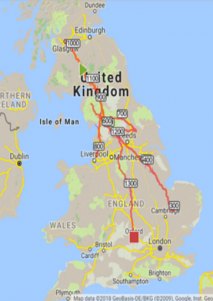Whilst the role of women in milling has often been underappreciated they have been crucial to its development. From its very origins with hand milling to today’s large-scale roller mills they have played a huge role.
Millers

Milling had its origins in Saddle and Rotary Querns and these were worked by slaves or women. However with increasing mechanisation milling was subject to an image change as it became seen to be the role of men.
Despite this image reversal, mills up until the industrial revolution were family affairs. Mill houses were close to the mill, so the miller’s family was in the immediate vicinity of the mill. The 1881 census returns demonstrate that this led to unofficial working relationships with female relatives often referring to themselves as ‘Miller’s Wife’ or ‘Miller’s Daughter’. Widows would often inherit mills on the death of their husband and either would continue to operate them or kept them running until their sons came of age to take over.
Even with industrialisation women would continue to play a role, particularly working in the large-scale textile mills such as those in Lancashire and Yorkshire. Then at the outbreak of the First and Second World Wars women took over jobs that were traditionally associated with men, as they were away fighting.
Caravan campaigning

E. M. Gardner is responsible for the large Gardner Collection held by the Mills Archive. An avid watermill enthusiast, she was responsible for the expansion of SPAB’s windmill section in 1946 to include watermills despite initial resistance by SPAB. Gardner’s influence does not, however, finish here as the 1911 Census records her as a ‘Women’s Suffrage Organiser’ for the NUWSS, and it is in this role she spent the summer of 1908 in a small horse-drawn caravan.

Gardner was involved in two caravan tours to promote the campaign for women’s suffrage. The first in July 1908, she alongside other students from Newnham College Cambridge, took a train to Glasgow and then worked their way back down to Oxford in their caravan. The journey was a huge undertaking of a rough distance of 1380.29 miles, even more, spectacular considering they took turns to travel ahead by bicycle to make arrangements. We can get an impression of their abilities as campaigners from the 17th July edition of the Lakes Herald,
‘their powers of eloquence were such as would put to shame many a male speaker who has figured on a local political platform’.
The report goes on to describe Gardner’s speech as Ambleside. She argued that the industrial system was held up by women workers and that this being the case, why in the sporting world were handicaps placed on the strong whilst ‘here in the political world they placed the handicap on the weak’, her speech concluded to rapturous applause and the setting up of a branch of the NUWSS
‘she asked for the men’s help in bringing about a better statute of things, so that man and women could go forward side by side in a work which they as English men and women must have at heart’.
This journey was not only an epic undertaking on the campaign scale, but as can be expected also involved little mishaps and adventures along the way. It began with Miss Gardner and some of the others losing their luggage on the train to Glasgow. A particularly amusing misadventure is described in a letter by Ray Costelloe, one of the other women in the travelling party. Ras and some of the others had been invited for afternoon tea with a supporter.
‘After this, we went back to our camping place for a few minutes rest and to compose speeches. Here we found Emilie and Teresa (whom we had left in the lunch at Grasmere) and they were both in rages. But affairs were tided over and somehow, Emilie induced to speak.’
_200_319.jpg)
What is incredible is that not content with this undertaking, Miss Gardner got straight back on the campaign trail and in August 1908 travelled around Yorkshire with two other women in another caravan. This tour began in Whitby in August 1908. To spread their message further, photographs were taken of these tours and turned into postcards. To the left, you can see one such postcard from this tour with E.M. Gardner standing on the left of the caravan. A postcard from Miss Gardner also describes how she was taken out on a lifeboat at Whitby during a demonstration! This tour again lasted for a month and Miss Gardner’s reports published in the Women’s Franchise describe a successful campaign including that they sold out of their famous badges.
Caravanning as a pastime really took off right around the growth of the Suffrage movement with the Caravan Club of Great Britain and Ireland being formed only a year prior to the Yorkshire tour, as such the two concepts became swiftly linked and it wasn’t long before the suffrage caravan tour entered the public imagination as can be seen in this postcard.
Alongside these tours, Gardner gave talks at various meetings and Secretary for the Birmingham and Midlands Branch of the NUWSS.
It is fantastic to find that the determination and energy Emilie Gardner brought to the preservation of watermills can also be seen in her pioneering spirit as she toured the country in a small horse-drawn caravan.
Pictures of the Caravan Tour used with the kind permission of the Women’s Library at LSE.
Further reading
See some items on the role women have had in milling on our Gems pages here.

